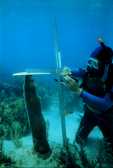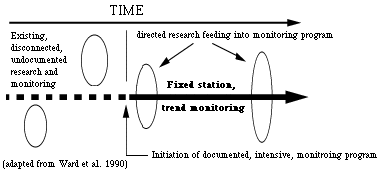

![]()
Have a Question or Comment?
What can we do to make this site more useful to you?
Note: Adobe Acrobat Reader required for PDF documents.
Problems accessing PDF documents?
Download the document to disk:
Mac Users: Option-click
PC users: Right-click
Last Updated: September 22, 2008
Sanctuary Permits
Research and monitoring are critical to achieving the Sanctuary's primary goal of resource protection. The Keys' ecosystem is diverse and complex, and many of its processes and their interrelationships are not well known. Also, while many resource impacts are obvious and severe, they are often not documented or quantified, and their causes may be even less clear or completely unknown. The purpose of research and monitoring is to establish a baseline of information on the resource and the various components of the ecosystem, and how they interact. In this way, research and monitoring can ensure the effective implementation of management strategies using the best available scientific information. Research and monitoring activities must focus on fundamental processes and specific management-driven topics. Information generated from such activities will be used to:
Two laws require that a research and monitoring program be implemented within the Sanctuary. Section 309 of the NMSA mandates that the “Secretary of Commerce shall take such action as is necessary and reasonable to promote and coordinate the use of national marine sanctuaries for research, monitoring, and education purposes.” The 1992 amendments to the FKNMSPA (Section 7(a)(4)) are much more specific, calling on the Secretary of Commerce to:
This web document and its associated pages describes current efforts underway to establish and continue a long-term, intensive, Sanctuary-wide monitoring program that is linked to a variety of different research efforts. |
 |
Both research and monitoring activities are in this plan because they employ similar methods, are often conducted by the same people and agencies, and must be linked to one another. Research is goal-oriented with well-defined, testable hypotheses, and is of finite duration. Monitoring involves systematic long-term data collection and analysis to measure the state of the resource and detect changes over time. Detecting such changes can prompt management decisions, can be used to evaluate the success of management strategies, or to focus research on determining the reason for the change (Fig. 1).
| Figure 1 |
 |
The primary goal of the Research and Monitoring Program is to provide the knowledge necessary to make informed decisions about protecting the biological diversity and natural ecosystem processes of the Sanctuary and its resources.
Sanctuary Goals: Two acts, the NMSA and the FKNMSPA, establish additional research and monitoring goals, including the:
- identification of priority areas for research;
- establishment of an ecological monitoring program;
- development of standards based on biological monitoring or assessment to ensure the protection and restoration of water quality, coral reefs, and other marine resources;
- establishment of a comprehensive water quality monitoring program to determine the sources of pollution and evaluate the results of pollution-reduction efforts;
- evaluation of progress in achieving water quality standards and protecting and restoring the Sanctuary's coral reefs and living marine resources;
- establishment of strong communication and cooperation between the scientific community and resource managers;
- coordination of research efforts to achieve the most beneficial results; and
- promotion of public awareness and resource stewardship.
Sanctuary Objectives: To achieve these goals, the following objectives should be met:
- provide leadership and coordination in research and monitoring activities by: a) recruiting other institutions to carry out priority actions under the Sanctuary program, including volunteer groups that can foster an attitude of community stewardship; and b) registering researchers within the Sanctuary in order to share information about research activities and encourage coordination and cooperation among scientists and resource managers;
- outline information needs and set priorities for research and monitoring that address issues related to management actions to be implemented and evaluated over the next five years, such as: a) baseline studies and long-term monitoring programs addressing water quality and the evaluation of water quality improvement strategies; b) studies on the impacts to habitats and their recovery from physical damage, as well as the effectiveness of restoration actions; c) baseline surveys and long-term monitoring that measure the ecological effects of establishing no-take zones and Wildlife Management Areas; and d) studies that distinguish human impacts from natural variability and contribute to biologically-based standards for the sustainable use of the Sanctuary;
- encourage and provide support for research and monitoring that lead to a better understanding of key ecological processes and criteria for recognizing ecological change;
- take a lead role in making the results of research and monitoring efforts available to all audiences, either directly or through collaborating institutions;
- ensure research is funded on an open and competitive basis;
- coordinate research permitting among agencies; and
- use research and monitoring results to evaluate management actions and improve them accordingly.
Both the Environmental Protection Agency (EPA) and the National Oceanic and Atmospheric Administration (NOAA) have direct mandates to conduct monitoring efforts in the Sanctuary. The integration of their efforts occurs through the management committee which has oversight over the Technical Advisory Committee (TAC). The TAC is composed of 24 scientists and resource managers involved in the South Florida ecosystem and provides advice and assistance to NOAA and EPA on the prioritization and design of the research and monitoring programs. It also assists with research RFP's, serves to integrate the research and monitoring efforts, and serves to integrate interagency efforts.
Through MOU's, the Sanctuary has designated the National Marine Fisheries Service (NMFS) Southeast Fisheries Science Center as the reef fish monitors and the National Undersea Research Center (NURC) as the research arm of the Sanctuary.
Data Management: The Florida Marine Research Institute is developing a data management system which will include raw data, metadata, and mapping tools which will be accessible on the Internet. The goal is to make the data accessible to researches and managers as quickly as possible.
NOAA's National Ocean Service and the Florida Fish and Wildlife Conservation Commission's Florida Marine Research Institute (FMRI) are implementing jointly the "Florida Keys Ecosystem Monitoring Integration" project. The initiative is designed to fulfill NOAA's responsibility under the Florida Keys National Marine Sanctuary and Protection Act, which calls for the establishment of a long-term ecological monitoring program and database for South Florida, Florida Bay, and the Florida Keys. It also supports and enhances state and federal restoration efforts of the South Florida environment.
Over the past year descriptive, site-specific data about ongoing, planned, or historical monitoring projects were collected by NOAA and FMRI through on-site interviews with principal investigators. These data have been included in an ArcView based GIS that allows users to conduct queries by location, time, theme, or other data combinations. Tabular summaries, charts, and maps can be produced from this system.
The monitoring data base and the GIS are prerequisites for developing a Florida Keys marine ecosystem monitoring plan. This plan will be developed through a series of structured, collaborative workshops that will be issue-oriented and will rely upon the knowledge and experience of the workshop participants. The resulting regional monitoring plan is expected to provide not only consensus on the details of a monitoring program (such as the hypotheses to be tested, location and number of monitoring sites, frequency of measurement, etc.), but also alternatives and priorities based on available resources and short-term versus long-term information needs. The plan also will indicate clearly the roles and requisite activities of each participant.
Research Affilitates
Research is conducted by many groups, including local, State, and Federal agencies; public and private universities; private research foundations; environmental organizations; and independent researchers. Leading research groups include:
- NOAA's on-site National Marine Sanctuary System and National Marine Fisheries Service (NMFS) staff
- NOAA's on-site National Undersea Research Center (NURC) at the University of North Carolina-Wilmington. Since 1991, NURC's Florida program has been a major sponsor of undersea research in the Sanctuary. Using the Aquarius undersea laboratory and surface boats, scientists conduct research in the following areas: reef health, reef development, water quality, fisheries, and ecology.
- The US Geological Service's Center for Coastal Geology maps and conducts geological research in the Florida Keys.
- The Florida Fish and Wildlife Conservation Commission (FWC), Florida Marine Research Institute (FMRI) (St. Petersburg and Long Key laboratories);
- The University of Miami's Rosenstiel School for Marine and Atmospheric Sciences;
- The State university system coordinated through the Florida Institute of Oceanography (FIO). The most active universities are the University of Florida, the University of South Florida, and Florida International University. FIO collaborates with the e FDEP in running the Long Key Lab (Keys Marine Lab).
- Mote Marine Laboratory and Mote's Florida Keys Tropical Research Laboratory
The Water Quality Protection Program
A number of monitoring activities are occurring in or near the Keys. The most comprehensive, long-term monitoring program underway in the Keys is conducted through the Water Quality Protection Program (WQPP) funded by USEPA. The WQPP monitoring program began in 1994 and consists of three components: water quality, corals/hardbottoms, and seagrasses. The following are some of the monitoring efforts that are occurring in this area:
| Corals: | Coral population dynamics are being monitored at 42 fixed stations throughout the Keys as part of the WQPP. Historical monitoring has been done throughout the Keys by the NMFS, FWC, SEAKEYS, and the College of Charleston. |
| Water Quality: | As part of the WQPP , trends in water quality are being monitored at 154 fixed stations from Key Largo to the Dry Tortugas. Parameters such as nutrients, salinity, turbidity, and phytoplankton biomass have been measured since 1995 by researchers from SERC, Florida International University. |
| Fish: | The NMFS and the FWC monitor recreational and commercial catch statistics concerning commercially important species. NMFS' Reef Resources Team has been gathering baseline data on reef fish populations in and around the no-take zones since 1993. |
| Seagrass: | Seagrass dynamics are being monitored at 51 sites throughout the Sanctuary as part of the WQPP. The National Park Service (NPS) and the University of Virginia monitor seagrass productivity in Everglades National Park. |
| Mangroves: | The NPS in Everglades National Park is evaluating the effects of sea level rise on mangroves. |
| Benthic Organisms: | NOAA, Biscayne National Park, and the FWC are monitoring organisms such as spiny lobster, sponge, conch, stone crabs, and Diadema. NOAA's National Status and Trends Program monitors one mollusk in the Upper Keys for toxic contamination. |
| Algal Blooms: | TNC and the FWC have been monitoring and mapping algal blooms in Florida Bay and the Sanctuary. This study covered the years 1994 - 1997. |
| Integrated Monitoring: | NOAA's National Ocean Service and the Florida Department of Environmental Protection's Florida Marine Research Institute (FMRI) are implementing jointly the "Florida Keys Ecosystem Monitoring Integration" project. |
